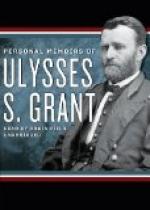Admiral Porter proceeded with the preparation of the steamers for their hazardous passage of the enemy’s batteries. The great essential was to protect the boilers from the enemy’s shot, and to conceal the fires under the boilers from view. This he accomplished by loading the steamers, between the guards and boilers on the boiler deck up to the deck above, with bales of hay and cotton, and the deck in front of the boilers in the same way, adding sacks of grain. The hay and grain would be wanted below, and could not be transported in sufficient quantity by the muddy roads over which we expected to march.
Before this I had been collecting, from St. Louis and Chicago, yawls and barges to be used as ferries when we got below. By the 16th of April Porter was ready to start on his perilous trip. The advance, flagship Benton, Porter commanding, started at ten o’clock at night, followed at intervals of a few minutes by the Lafayette with a captured steamer, the Price, lashed to her side, the Louisville, Mound City, Pittsburgh and Carondelet—all of these being naval vessels. Next came the transports —Forest Queen, Silver Wave and Henry Clay, each towing barges loaded with coal to be used as fuel by the naval and transport steamers when below the batteries. The gunboat Tuscumbia brought up the rear. Soon after the start a battery between Vicksburg and Warrenton opened fire across the intervening peninsula, followed by the upper batteries, and then by batteries all along the line. The




